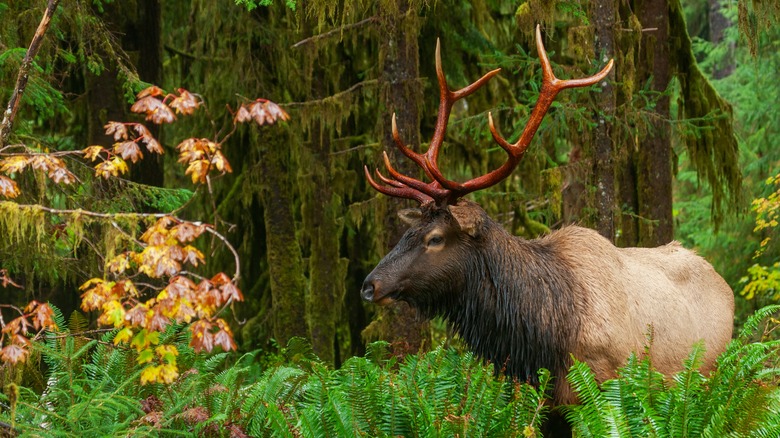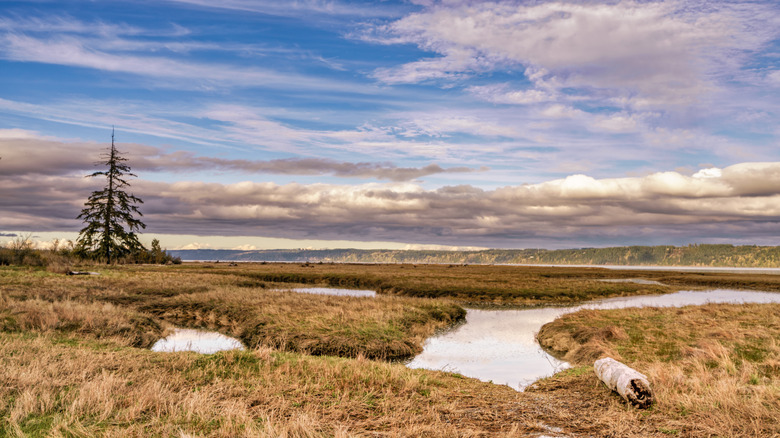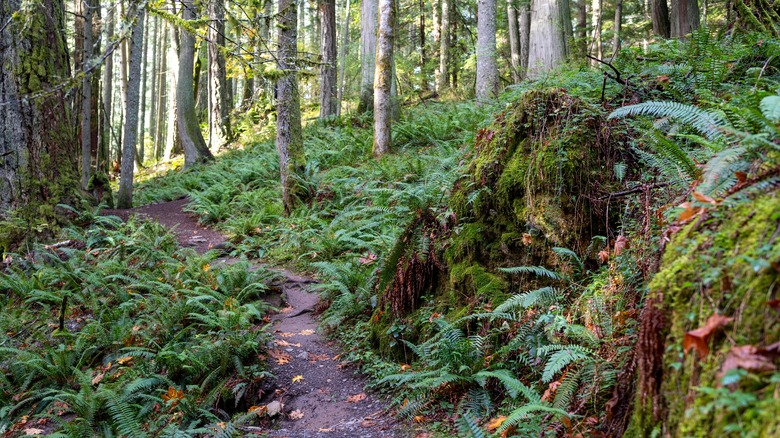The 5 Best Washington Parks For Seeing Rare Or Endangered Wildlife
The state of Washington has earned a reputation as being one of the most beautiful in the country. With a combination of picturesque coastlines, enchanting forests, and towering mountains, Washington seems at times almost unbelievably stunning. Many of the state's top outdoor destinations center around its breathtaking mountains, like the iconic Mount Rainier and its distinctive Swiss Alps vibes. However, Washington's extensive collection of parks, preserves, and other public lands also serves as home to a multitude of amazing plant and animal species. Many of these parks represent a diverse range of ecosystems, including marine and coastal environments, mountain meadows, and even rare temperate rainforests. Such ecological diversity means a variety of animal residents as well, many of which are rarely seen elsewhere.
Washington has several parks that are home to rare, threatened, or outright endangered species. Both state agencies, like the Washington Department of Fish and Wildlife, and federal agencies like the National Park Service, oversee the management (and conservation) of these rare and endangered animals. As a result, you can find these remarkable creatures in both state parks and federal lands.
Washington's ecological diversity also means variety in its rare and endangered species. You might, for example, see uncommon terrestrial animals like grizzly bears, wolves, or mountain goats at one of its mountainous parks, and then head to a coastal park to see rare whales and other marine mammals. And, of course, the skies above Washington's parks are home to a rich tapestry of both resident and migratory birds, including rare and cherished additions to your birding lifebook. While all Washington state and national parks have amazing wildlife, these five in particular offer the best opportunities to see rare and endangered animals in person.
Willapa National Wildlife Refuge
Unsurprisingly, a self-described "wildlife refuge" is an excellent place to spot rare and endangered wildlife. Washington actually has several excellent wildlife refuges you can visit, each with a diverse population of amazing creatures, big and small. However, if you can only visit one, the exceptional Willapa National Wildlife Refuge offers arguably the best menagerie of animals from the land, sea, and air. The preserve sits at the southern end of Washington's Willapa Bay, at the base of the prominent Long Beach Peninsula. Willapa Bay itself is one of Washington's more intriguing features, with the riverine estuary nestled among lush forests and even the remnants of woodlands buried under rock by ancient earthquakes.
Within its unique environment, Willapa National Wildlife Refuge protects 21,000 acres of diverse ecosystems, including beaches, tidelands, inland streams, and old-growth cedar forests. And with this impressive diversity of ecosystems comes an equally remarkable diversity of wildlife. Willapa's fertile coastal habitats provide excellent homes for animals that love both the land and the water. This includes notable species like river otters, beavers, and the threatened Steller sea lion. Further inland, Willapa also has notable populations of black bears and mountain lions. However, the Willapa's rarest treasure may be its population of Roosevelt elk — the largest elk species in North America that's only found in the coastal mountains and forests of the Pacific Northwest.
Birdwatching enthusiasts will particularly enjoy Willapa's significant populations of rare and beautiful birds like the western snowy plover and the majestic (and loud) trumpeter swan. Offshore, Willapa's coastal waters provide safe passage for gray whales during their annual migration, as well as the occasional pod of orcas. Willapa's many hiking trails provide excellent vantage points for seeing its animal residents from a safe distance.
Dosewallips State Park
While most of Washington's famous parks are administered by the federal government, there are also plenty of amazing state parks that are equally rich in animal life. Dosewallips State Park is a particularly illustrious sample of Washington's complex ecology. Like other biologically rich Washington parks, Dosewallips features a complex synthesis of land and water features drawn from the park's unique geography. Dosewallips sits between the Dosewallips River and the Hood Canal. Much of the park's terrain, therefore, consists of expansive meadows interspersed with water systems, with the prominent Olympic Mountains adding a higher-altitude flavor to the mix.
The integration of the Hood Canal and Dosewallips River provides a one-of-a-kind hydrological quality to the park's impressive ecosystem. Despite its name, the Hood Canal is not actually a "canal," but rather a natural fjord between the Puget Sound and the Olympic Mountains. The Dosewallips River is something of the canal's mirror image, originating in the Olympic Mountains and emptying into the ocean via the Hood Canal. The merging of these two water systems provides Dosewallips State Park with both saltwater and freshwater environments, perfect for a diverse community of animals to thrive.
The park's coastal areas are among the best places in Washington to find shellfish, boasting abundant populations of oysters, geoducks, and several native species of clam. Like the Willapa National Wildlife Refuge, Dosewallips State Park is an excellent place to see Washington's rare herds of elk. Notably, the elk in the park are acclimated enough to human presence that you'll have a great chance of spotting them (though make sure you still follow proper wildlife safety protocols and keep your distance). Dosewallips and the Hood Canal are also home to more than 250 species of birds, while the waters just offshore sometimes host visible groups of orcas.
Moran State Park
Moran State Park is one of the jewels of the San Juan Islands, a vibrant archipelago in the Salish Sea just off the coast of northwest Washington. Specifically, Moran State Park is part of the splendid Orcas Island. With a rich mix of lush forests, glimmering lakes, and opportunities for adventure, Orcas Island is one of Washington's most underrated destinations. Within this complex island ecosystem, Moran State Park preserves a delicate tapestry of ecological niches, including forests, lakes, wetlands, and even mountain habitats, courtesy of the nearly half-mile-high Mount Constitution.
Moran State Park is not only the largest park in the San Juan Islands — it also features the archipelago's most diverse terrain. This stunning blend of different ecosystems means a plethora of notable animal residents well within view of visitors. With 5,252 acres and five different lakes, Moran boasts an intricate blend of terrestrial animals, marine animals, and birds, including several eye-catching species like trumpeter swans, river otters, mink, and bald eagles. However, in terms of rare animals, Moran State Park's most notable residents are its extraordinary population of piebald deer.
Strictly speaking, piebald deer are not actually a separate species. Rather, Moran's piebald deer are actually black-tailed deer with a rare color morph that causes distinctive patches of white hair mixed with their normal brown hair. While piebald deer can be born anywhere, this specific color morph is quite rare among most deer populations, occurring in only around 1% of deer that are born each year. However, this eye-catching color is much more common in the isolated population of black-tailed deer on Orcas Island. Moran State Park, therefore, offers the best chance you'll likely ever have to see these rare, colorful animals in the wild!
North Cascades National Park
The magnificent North Cascades National Park is one of the most pristine and wild sites in the entire National Park System. Protecting a complex wilderness area in and around the rugged North Cascade mountains, the park is a veritable paradise of snow-capped mountain peaks, unadulterated forests, and some of the wildest woodlands in the contiguous United States. Spring and summer bring an abundance of rich greens and vibrant wildflowers to the park, but in the winter months, the gorgeous and underrated North Cascades become one of the world's snowiest places! All-in-all, North Cascades National Park is unequivocally wild through and through, and with this ruggedness comes an extensive web of all sorts of remarkable animal species.
For millennia, the vast forests of the North Cascades served as home to large populations of grizzly bears. Unfortunately, hunting and habitat destruction led to a significant decline in grizzly bear populations in the Pacific Northwest, eventually eradicating the North Cascades grizzly bears entirely. However, in recent years, the National Park Service and U.S. Fish & Wildlife Service have undertaken major efforts to restore grizzly bear populations to North Cascades National Park. As a result of these efforts, the park is now one of the best places in the United States (outside of Alaska) to see grizzly bears in the wild.
While encountering a grizzly bear up close is probably not what you'd want on your wilderness excursion, viewing these incredible animals from a safe distance is a truly unforgettable experience. In addition to restored grizzly bear populations, North Cascades National Park is also home to gray wolves, mountain goats, lynx, and other rare mammals. Many birds are also found in the park, including threatened species like bald eagles, marbled murrelets, and spotted owls.
Olympic National Park
One common theme among Washington's most ecologically rich parks is a unique blending of mountains, forests, and coastlines into one biodiverse tapestry. Within this category, the breathtaking Olympic National Park stands out. Taking its name from the incredible Olympic Peninsula where it resides, Olympic National Park has a manifold of different types of ecosystems that stand out even among the fierce competition of the National Park System.
The Olympic National Park's nearly 1 million acres include mountain ecosystems, coastal ecosystems, and old-growth forests that protect a diverse variety of life. The park's Olympic Mountains feature fertile montane forests with several rare and majestic animals, including elk, bobcats, and mountain lions (not to mention plenty of birds of prey). More famously, the one-of-a-kind Hoh Rainforest, a prominent example of a rare temperate rainforest, contains Washington's rare black bears, mountain lions, river otters, and a few slimier denizens like the banana slug.
While Olympic's numerous forests are home to impressive land animals, its marine ecosystems are equally rich in wildlife. The park's 73 miles of coastal wilderness lie within the Olympic Coast National Marine Sanctuary, sharing the area's incredible community of fish, seabirds, and marine mammals. Olympic's coastal area is an excellent place to spot photogenic, yet rare, animals like gray whales, sea otters, and Steller's sea lions, with a colorful garden of invertebrates waiting in lovely tidepools. Away from the shore, Olympic's ravishing embroidery of rivers and lakes provides homes for several fish species, including anadromous fish species like salmon. And when you have a fertile network of different ecosystems, the air above them also tends to be filled with more than a few birds. If you're an avid birdwatcher, Olympic National Park provides superb opportunities to see around 300 bird species, including falcons, owls, and woodpeckers.





